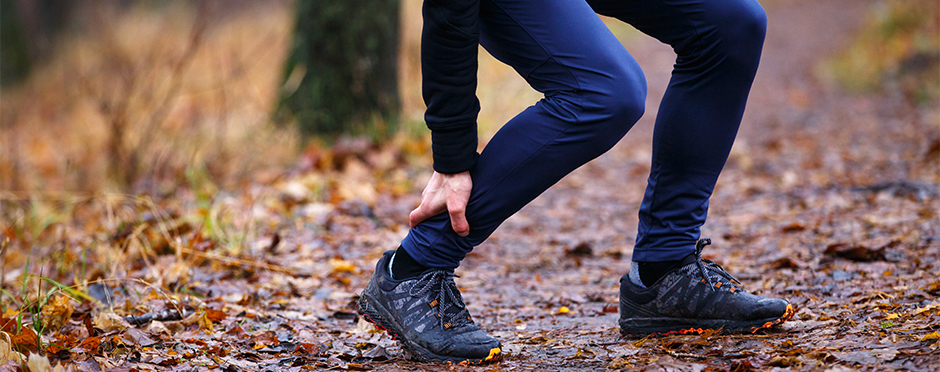
Achilles Tendinopathy in Runners: Your Aching Heel Pain Can Be Helped
Leave a CommentDoes the aching pain in your heel have you adjusting your training program this running season?
Countless runners suffer from Achilles tendon injuries every year and these injuries can often be a limiting factor in your ability to maintain a training program, advance your mileage and meet your personal record goals. The good news is that we have therapists at Athletico trained and prepared to help you overcome this injury and get back to pounding the pavement.
Achilles Tendinitis vs. Achilles Tendinopathy
Over the past several years, there has been a lot of research regarding Achilles tendon injuries and the best treatments. So much so, that the name itself has undergone transformation to help both patients and healthcare providers adapt their treatment recommendations. What was once identified as Achilles tendinitis is now more appropriately termed Achilles tendinopathy or tendinosis.
For runners, Achilles tendinitis incorrectly identified all Achilles-related pain as being primarily inflammatory in nature. This can lead patients and healthcare providers down a path of rest, ice and anti-inflammatories. While these options can be effective in initially reducing pain in an acute injury, if the condition has lasted longer than two weeks, inflammation is no longer the primary driving factor causing pain. In fact, many research studies have documented the detrimental effects that anti-inflammatories can have on tendon healing when not combined with other treatment options.1
Instead, Achilles tendinosis is related to the repeated heavy loads subjected to the tendon that often occurs while running, which can result in the deformation of tendon.2 A healthy tendon has well organized parallel fibers that act in line with the muscle to create power and movement. Tendinosis typically involves disorganized non-parallel fibers that lack structure. Exposing this tendon to additional repetitive load serves to perpetuate this process unless treatment is applied. The end result for runners is pain, weakness, poor endurance and an inability to train at a high level.
Treatment Options
With an understanding of the condition, we can more appropriately provide treatment. In a recent research study, it was shown that both eccentric exercise training and training with heavy loads and slow speed improved Achilles tendon pain by following a progressive loading protocol.3 Various manual therapy techniques also have supportive evidence, including instrument assisted soft tissue mobilization.4 These techniques utilize tools to assist with stimulating blood flow, thereby attracting healing properties to the tendon and improving mobility. What’s more, utilizing therapeutic elastic tape can assist with reducing pain and improving function as you continue your training program.5
It is important to note that pain may also be related to running mechanics. A trained physical therapist at Athletico can assist with identifying potential flaws in your running mechanics that may lead to overloading the Achilles. Beyond these treatments, a thorough evaluation of your strength, flexibility, joint mobility and function will help to tailor an individual treatment plan that helps speed up your recovery.
Get Treatment and Continue Training
The good news is that many of these conditions can be treated while you continue training. Additional research shows that patients who participate in a treatment program while also maintaining recreational activities can improve just as much as those that were advised to rest. So don’t let this pain stop you from completing your goals.6 Stay active and seek out treatment from a physical therapist that knows how to appropriately treat Achilles tendinopathy.
At Athletico Physical Therapy, we have therapists specifically trained in the treatment of runners and use advanced level therapy techniques to address your condition and technology to analyze your running mechanics. Click below to schedule an appointment.
The Athletico blog is an educational resource written by Athletico employees. Athletico bloggers are licensed professionals who abide by the code of ethics outlined by their respective professional associations. The content published in blog posts represents the opinion of the individual author based on their expertise and experience. The content provided in this blog is for informational purposes only, does not constitute medical advice and should not be relied on for making personal health decisions.
References:
1. Dahners LE, Mullis BH. Effects of nonsteroidal anti-inflammatory drugs
on bone formation and soft-tissue healing. J Am Acad Orthop Surg.
2004;12:139-143.
2. Kaeding C, Best T. Tendinosis: Pathology and Non-Operative Treatment. Sports Health. 2009; 1(4): 284-292
3. Beyer R, Kongsgaard M, Hougs Kjaer B, Øhlenschlæger T, Kjaer M, Mag¬nusson SP. Heavy slow resistance versus eccentric training as treatment for Achilles tendinopathy: a randomized controlled trial. Am J Sports Med. 2015;43:1704-1711.
4. Cheatham SW, Lee M, Cain M, Baker R. The efficacy of instrument as¬sisted soft tissue mobilization: a systematic review. J Can Chiropr Assoc. 2016;60:200-211.
5. Firth BL, Dingley P, Davies ER, Lewis JS, Alexander CM. The effect of kinesiotape on function, pain, and motoneuronal excitabil¬ity in healthy people and people with Achilles tendinopathy. Clin J Sport Med. 2010;20:416-421.
6. Silbernagel KG, Brorsson A, Lundberg M. The majority of patients with Achilles tendinopathy recover fully when treated with exercise alone: a 5-year follow-up. Am J Sports Med. 2011;39:607-613.
